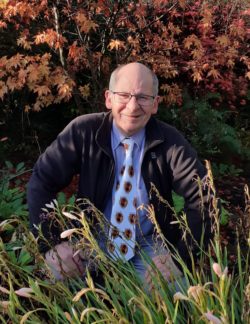
Education
1979 Ph.D. National Unversity of Ireland; 1975 M.Sc. Oceanography, University of Southampton, UK; B.Sc. Biochemistry, University of Birmingham, U.K.
Life and Professional Career
Robin moved to Ireland from the UK in 1975 where he researched carbon cycling in inshore and oceanic realms. Based in Galway, his deep-sea studies established strong links with the Scottish Marine Biological Association laboratory at Oban (now the Scottish Association for Marine Science). In 1985, he went to study at Oban for nine months, working with Paul Tett and Ken Jones, where he was introduced to the worlds of modeling and, more importantly, phytoplankton.
Returning to Ireland, he formed the “Irish Phytoplankton Research Group”, as the numbers of people working in this area in Ireland were very few and scattered across the country. As a group of volunteers (without funding), they received ship time on the national research vessel to carry out studies in Irish waters, which quickly led to a realization of the complexities of processes governing both the healthy fertility and harmful blooms of waters around the southwest of Ireland. So started the SWEAT (Southwest Ecology and Algal Toxicology) programme which lasted for 15 years.
Ireland is a small country, and in the course of his research Robin was directly involved in disparate activities, introducing the first undergraduate course on phytoplankton ecology in Irish universities, organizing national (and international) phytoplankton identification courses, and was involved in the design and scientific operation of the national research vessels.
Through the various research funding avenues available, Robin developed strong international links within the HAB community, and was nominated onto the scientific Steering Committee (SSC) of GEOHAB in 2003. He became chairman of the GEOHAB SSC in 2006, and initiated the development of a new research project on sand-dwelling and epiphytic HAB species, as well as the commencement of the regional programme GEOHAB Asia.
Robin became vice-president of ISSHA in 2014. Ever since, he is our Honorary ISSHA auctioneer, hilarious but efficient, in control of time, at the conferences in Wellington (2014), Florianópolis (2016) and Nantes (2018).
Robin is devoted to his PhD students, and transmits enthusiasm and optimism. In his free time, he is an excellent guitar player. He also maintains an exquisite garden where herbs are mixed artistically with flowers and vegetables in raised beds with home made compost.
Key HAB contributions
Robin’s research on HABs first concentrated on the links between physical oceanography and harmful blooms along the coast of southwest Ireland, during which he published key papers on our ability to predict these blooms and the role of coastal flows in transporting HABs, in particular Dinophysis and Karenia, towards sites of shellfish culture. Two major research programmes followed, the first of which was the study of the dynamics of Alexandrium spp. in Cork Harbour. The second was a study of Dinophysis behaviour and ecology, in collaboration with Patrick Gentien and Beatriz Reguera. Initially focusing on its existence in sub-surface thin layers, this research has continued with annual field studies across the continental shelf waters of the Celtic Sea, establishing the offshore sites where Dinophysis blooms occur.
Robin’s passion for phytoplankton and sea-going research has inspired and enthused both students and colleagues alike. It is fitting that much of the work he undertook latterly, was in developing innovative training and ocean literacy programmes to help inspire and grow a new generation of marine scientists.
Mentored
Caroline Cusack, Shane O’Boyle, Pauhla McGrane, Georgina McDermott, Sandra Lyons, Aoife Ni Rathaille, Nicolas Touzet, Linda Ahern, Hazel Farrell, Gary McCoy, Sarah Cosgrove, and Clynton Gregory
10 Key HAB publications
Raine, R., 2017). Harmful Algal Blooms. An e-book for secondary level students. Available (free) at iTunes (for iPad only).
Raine, R., 2014. A review of the biophysical interactions relevant to the promotion of HABs in stratified systems: the case study of Ireland. Deep-Sea Res., 101, 21-31.
Cosgrove, S., Ní Rathaille, A., Raine, R., 2014. The influence of bloom intensity on the encystment rate and persistence of Alexandrium minutum in Cork Harbor, Ireland. Harmful Algae, 31, 114-124.
Farrell, H., Gentien, P., Fernand, M., Lunven, M., Reguera, B., Gonzales-Gil, S., Raine, R., 2012. Scales characterising a thin layer of Dinophysis acuta Ehrenburg and its transport within a coastal jet. Harmful Algae, 15, 36-46.
Reguera, B., Velo-Suárez, L., Raine, R., Park, M.G., 2012. Harmful Dinophysis species: a review. Harmful Algae, 14, 87-106
Ní Rathaille, A., Raine, R., 2011. Seasonality in the excystment of Alexandrium minutum and Alexandrium tamarense in Irish Coastal waters. Harmful Algae, 10, 629-635
Raine, R., McDermott, G., Silke, J., Lyons, K., Nolan, G., Cusack, C., 2010. A simple model for the prediction of harmful algal events in the bays of southwestern Ireland. J. Mar. Syst., 83, 150-157.
Hill, A.E., Brown, J., Fernand, L., Holt, J.T., Horsburgh, K.J. Proctor, R., Raine, R., Turrell, W.R., 2008. Thermohaline circulation of shallow tidal seas. Geophys. Res. Lett., 35 (11), L11605
Cusack, C., Bates, S.S., Quilliam, M.A., Patching, J.W., Raine, R., 2002. Confirmation of domoic acid production by Pseudo-nitzschia australis (Bacillariophyceae) isolated from Irish waters. J. Phycol., 38, 1106-1112.
Raine, R., O'Boyle, S., O'Higgins, T., White, M., Patching, J., Cahill, B., McMahon, T., 2001. A satellite and field portrait of a Karenia mikimotoi bloom off the south coast of Ireland, August, 1998. Hydrobiologia, 465, 187-193.
--
Prepared by Pauhla McGrane and Beatriz Reguera

